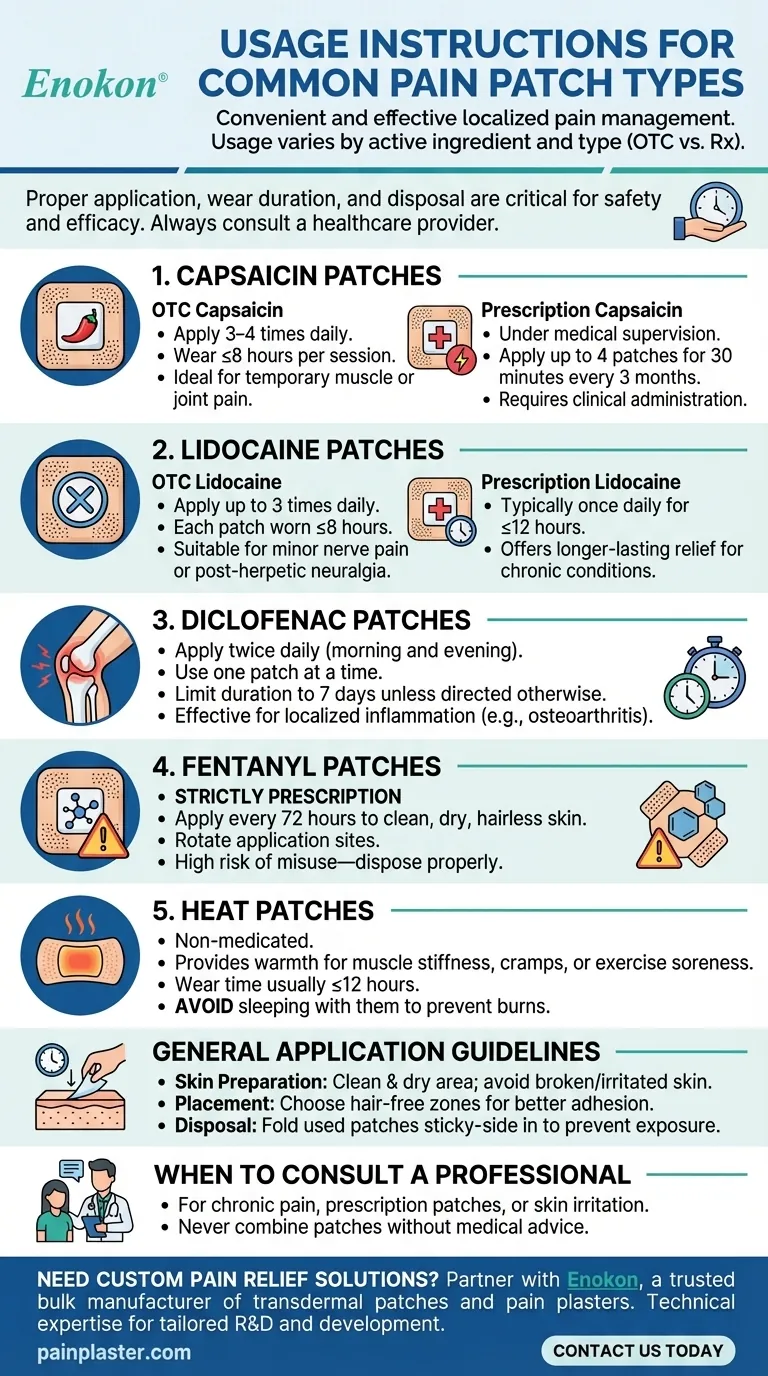Pain patches are a convenient and effective way to manage localized pain, but their usage varies significantly depending on the active ingredient and whether they are over-the-counter (OTC) or prescription-based. Key types include capsaicin, lidocaine, diclofenac, fentanyl, and heat patches, each with specific application guidelines. Proper skin preparation, adherence to wear duration, and disposal are critical for safety and efficacy. Always consult a healthcare provider for personalized instructions, especially for prescription patches like fentanyl or high-dose capsaicin.

Key Points Explained:
-
Capsaicin Patches
- OTC Capsaicin: Apply 3–4 times daily, leaving the pain patch on for no more than 8 hours per session. Ideal for temporary relief of muscle or joint pain.
- Prescription Capsaicin: Used under medical supervision. Apply up to 4 patches for 30 minutes every 3 months. Requires clinical administration due to high potency.
-
Lidocaine Patches
- OTC Lidocaine: Apply up to 3 times daily, with each patch worn ≤8 hours. Suitable for minor nerve pain or post-herpetic neuralgia.
- Prescription Lidocaine: Typically used once daily for ≤12 hours. Offers longer-lasting relief for chronic conditions like diabetic neuropathy.
-
Diclofenac Patches
- Apply directly to the painful area twice daily (e.g., morning and evening). Use one patch at a time; limit duration to 7 days unless directed otherwise. Effective for localized inflammation (e.g., osteoarthritis).
-
Fentanyl Patches
- Strictly prescription-based for severe pain. Apply every 72 hours to clean, dry, hairless skin. Rotate application sites to avoid irritation. High risk of misuse—dispose of used patches properly.
-
Heat Patches
- Non-medicated patches provide warmth for muscle stiffness, menstrual cramps, or exercise-related soreness. Follow package instructions for wear time (usually ≤12 hours). Avoid sleeping with them to prevent burns.
-
General Application Guidelines
- Skin Preparation: Clean and dry the area; avoid broken or irritated skin.
- Placement: Choose hair-free zones (e.g., upper arm, back) for better adhesion.
- Disposal: Fold used patches sticky-side in to prevent accidental exposure, especially for opioids like fentanyl.
-
When to Consult a Professional
- For chronic pain, prescription patches, or if skin irritation occurs.
- Never combine patches without medical advice (e.g., lidocaine with heat patches).
Understanding these nuances ensures safe, effective pain management while minimizing risks like skin reactions or systemic side effects. Have you considered how patch placement might affect absorption rates for different pain types?
Summary Table:
| Patch Type | Usage Instructions | Key Notes |
|---|---|---|
| Capsaicin (OTC) | Apply 3–4 times daily, ≤8 hours per session. | Ideal for temporary muscle/joint pain. |
| Capsaicin (Rx) | Apply up to 4 patches for 30 minutes every 3 months. | Requires clinical administration. |
| Lidocaine (OTC) | Apply ≤3 times daily, ≤8 hours per patch. | Suitable for minor nerve pain. |
| Lidocaine (Rx) | Apply once daily, ≤12 hours. | Used for chronic conditions like diabetic neuropathy. |
| Diclofenac | Apply twice daily (morning/evening), ≤7 days. | Effective for localized inflammation (e.g., osteoarthritis). |
| Fentanyl | Apply every 72 hours to clean, dry skin. Rotate sites. | High risk of misuse—dispose carefully. |
| Heat Patches | Wear ≤12 hours; avoid sleeping with them. | Non-medicated relief for stiffness/cramps. |
Need custom pain relief solutions? Partner with Enokon, a trusted bulk manufacturer of transdermal patches and pain plasters for healthcare distributors and brands. Our technical expertise ensures tailored R&D and development for your specific needs. Contact us today to discuss how we can support your pain management product line!
Visual Guide

Related Products
- Capsaicin Chili Medicated Pain Relief Patches
- Lidocaine Hydrogel Pain Relief Patch for Pain Relief
- Far Infrared Deep Heat Relief Patches Medicated Pain Relief Patches
- Heat Relief Capsicum Patch for Lower Back Pain Relief
- Asthma Cough and Pain Relief Patch for Adults and Kids
People Also Ask
- Can pregnant women use pain relief patches? Your Essential Guide to Safe Pain Management
- What side effects might occur from using capsaicin patches? Understand the difference between normal sensation and danger signs.
- Are pain relief patches safe for sensitive skin? Your Guide to Safe Use & Skin Testing
- What is the purpose of capsaicin patches? A Guide to Temporary Pain Relief
- How do you apply the Signal Relief patch to find the proper placement? A Step-by-Step Guide to Maximum Relief















